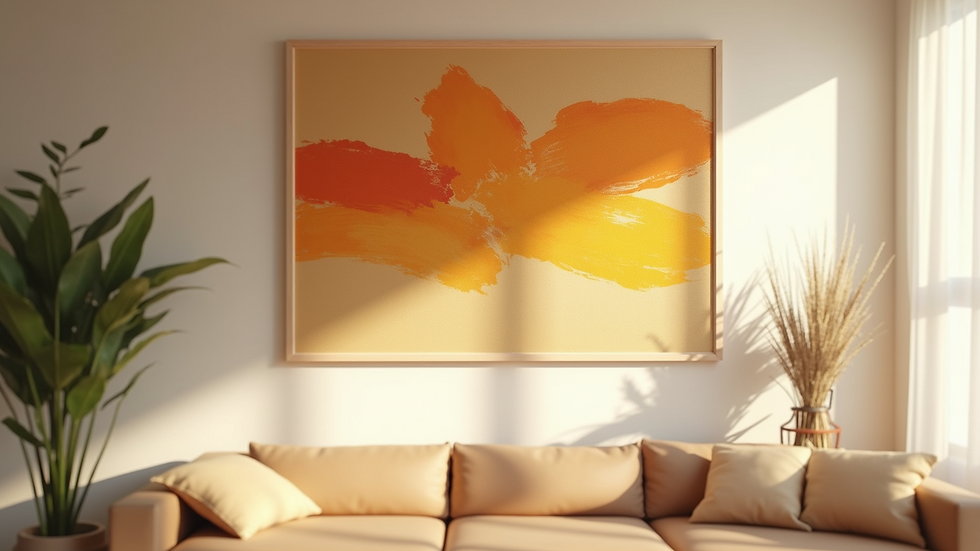Discover How Abstract Art Enhances Healing Spaces
- Ginger Martinez
- Nov 17
- 4 min read
When I first stepped into a room adorned with abstract art, I felt something shift inside me. It wasn’t just the colors or shapes that caught my eye—it was the way the art seemed to breathe life into the space, inviting calm and reflection. Healing spaces, whether in homes, clinics, or wellness centers, thrive on this kind of energy. And abstract art, with its fluid forms and emotional depth, plays a unique role in creating environments that nurture the soul.
Let me take you on a journey through the therapeutic abstract art benefits and how they transform ordinary rooms into sanctuaries of healing and inspiration.
Why Healing Spaces Need Therapeutic Abstract Art Benefits
Healing spaces are more than just clean, quiet rooms. They are environments designed to support emotional, mental, and physical recovery. The right atmosphere can reduce stress, encourage mindfulness, and even speed up healing. This is where therapeutic abstract art benefits come into play.
Abstract art doesn’t tell a story in a traditional sense. Instead, it evokes feelings and thoughts through color, texture, and form. This open-endedness allows each person to connect with the art in their own way. For example:
Colors like soft blues and greens can calm the mind and lower blood pressure.
Dynamic shapes and flowing lines can inspire movement and energy.
Layered textures invite touch and curiosity, grounding you in the present moment.
In healing spaces, these elements work together to create a sense of safety and emotional release. Patients and visitors often report feeling more relaxed and hopeful when surrounded by thoughtfully chosen abstract pieces.

How Therapeutic Abstract Art Benefits Emotional Well-being
Emotions are complex, and sometimes words just don’t cut it. Abstract art offers a language beyond words. It speaks directly to our feelings, often bypassing the noise of everyday life. This is why it’s so powerful in healing environments.
When I look at a piece of original abstract art, I don’t just see colors and shapes—I feel a story unfold inside me. That story might be one of hope, struggle, or peace. The ambiguity allows me to project my own emotions onto the canvas, making the experience deeply personal.
Here’s how therapeutic abstract art benefits emotional well-being:
Encourages self-expression: People can interpret the art in ways that reflect their inner world, helping them process emotions.
Reduces anxiety: The unpredictability of abstract forms can distract from worries and ground the mind.
Fosters mindfulness: Observing abstract art invites you to slow down and be present, a key factor in emotional healing.
In spaces like therapy rooms or meditation areas, abstract art becomes a silent companion, gently guiding visitors toward emotional clarity and calm.
Creating a Healing Space with Abstract Art: Practical Tips
If you’re thinking about enhancing a healing space with abstract art, here are some practical tips to get you started:
Choose colors thoughtfully. Soft, muted tones promote relaxation, while brighter colors can energize and uplift.
Consider the size and placement. Large pieces can dominate a room and create a focal point, while smaller works add subtle interest.
Mix textures and materials. Abstract art isn’t limited to paint on canvas. Think about sculptures, mixed media, or even textiles.
Balance complexity and simplicity. Too much detail can overwhelm; too little might feel empty. Find a middle ground that suits the space.
Involve the senses. Some abstract art pieces incorporate tactile elements or even sound, enhancing the healing experience.
Remember, the goal is to create a space that feels welcoming and supportive. Don’t be afraid to experiment and see what resonates with you and those who use the space.

The Science Behind Abstract Art and Healing
You might wonder if there’s any science backing up these feelings. The good news is—yes, there is. Studies in environmental psychology and art therapy have shown that abstract art can positively influence brain activity and emotional states.
For instance:
Brain scans reveal that viewing abstract art activates areas linked to emotion and reward.
Art therapy sessions using abstract art help patients express trauma and reduce symptoms of depression.
Hospitals incorporating abstract art report lower patient stress levels and improved satisfaction.
These findings highlight that abstract art isn’t just decoration—it’s a tool for healing. It taps into our innate need for beauty, meaning, and connection.
Bringing It All Together: Transform Your Space with Abstract Art
If you want to transform your space into a place of inspiration and reflection, abstract art is a powerful ally. It invites you to slow down, feel deeply, and connect with your inner self. Whether you’re an art lover or new to the world of abstract expression, there’s something magical about how these pieces can change the energy of a room.
I encourage you to explore collections of original abstract art that speak to your heart. Look for pieces that evoke emotion and invite contemplation. Place them where you spend quiet moments—your bedroom, meditation nook, or even your workspace.
By doing this, you’re not just decorating—you’re creating a sanctuary. A place where healing happens naturally, through the power of color, form, and feeling.
So go ahead. Let your walls tell a story that words can’t capture. Let abstract art be the gentle healer your space deserves.



Comments